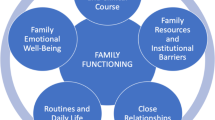Abstract
Growing empirical evidence has suggested an association between deployment experiences and adverse consequences among military families in terms of individual and family functioning. Military families are increasingly seeking the support of clinical social workers for both preventing and managing these adverse outcomes. The contextual model of family stress and coping, a family stress theory consistent with social work values, provides a clinically useful framework for designing effective interventions for this population. In this article, I apply this model to a case study to illustrate how this perspective can be used to both understand the experiences of military families and develop appropriate treatment plans for family therapy. Based on case information gathered by a social worker during a family assessment, I use the model to organize and understand the issues faced by this family and guide treatment.
Similar content being viewed by others
References
American Psychiatric Association. (2000). Diagnostic and statistical manual of mental disorders (4th ed., text rev.). Washington, DC: Author.
Barrio, C., Hernández, M., & Barragán, A. (2011). Serving Latino families caring for a person with serious mental illness. In L. P. Buki & L. M. Piedra (Eds.), Creating infrastructures for Latino mental health (pp. 159–175). New York, NY: Springer.
Boss, P. (2002). Family stress management: A contextual approach. Thousand Oaks, CA: Sage.
Bowen, G. L., Mancini, J. A., Martin, J. A., Ware, W. B., & Nelson, J. P. (2003). Promoting the adaptation of military families: An empirical test of a community practice model. Family Relations, 52, 33–44. doi:10.1111/j.1741-3729.2003.00033.x.
Calzada, E. J., Tamis-LeMonda, C. S., & Yoshikawa, H. (2013). Familismo in Mexican and Dominican families from low-income, urban communities. Journal of Family Issues, 34, 1696–1724. doi:10.1177/0192513X12460218.
Cederbaum, J. A., Gilreath, T. D., Benbenishty, R., Astor, R. A., Pineda, D., DePedro, K. T., Atuel, H. (2013). Well-being and suicidal ideation of secondary school students from military families. Journal of Adolescent Health. Advance online publication. doi:10.1016/j.jadohealth.2013.09.006.
Chandra, A., Lara-Cinisomo, S., Jaycox, L. H., Tanielian, T., Burns, R. M., Ruder, T., et al. (2010). Children on the homefront: The experience of children from military families. Pediatrics, 125, 16–25. doi:10.1542/peds.2009-1180.
Coolbaugh, K. W., & Rosenthal, A. (1992). Family separations in the army. Alexandria, VA: U.S. Army Research Institute for the Behavioral and Social Sciences.
Figley, C. R. (Ed.). (1978). Stress disorders among Vietnam veterans: Theory, research and treatment. New York, NY: Brunner-Routledge.
Flake, E. M., Davis, B. E., Johnson, P. L., & Middleton, L. S. (2009). The psychosocial effects of deployment on military children. Journal of Developmental and Behavioral Pediatrics, 30, 271–278. doi:10.1097/DBP.0b013e3181aac6e4.
Gibbs, D. A., Martin, S. L., Kupper, L. L., & Johnson, R. E. (2007). Child maltreatment in enlisted soldiers’ families during combat-related deployments. JAMA, 298(5), 528–535.
Gilreath, T. D., Cederbaum, J. A., Astor, R. A., Benbenishty, R., Pineda, D., & Atuel, H. (2013). Substance use among military-connected youth: The California healthy kids survey. American Journal of Preventive Medicine, 44, 150–153. doi:10.1016/j.amepre.2012.09.059.
Hill, R. (1958). Generic features of families under stress. Social Casework, 39, 139–150.
Hoge, C. W., Castro, C. A., Messer, S. C., McGurk, D., Cotting, D. I., & Koffman, R. L. (2004). Combat duty in Iraq and Afghanistan, mental health problems, and barriers to care. New England Journal of Medicine, 351, 13–22. doi:10.1056/NEJMoa040603.
Lester, P., Peterson, K., Reeves, J., Knauss, L., Glover, D., Mogil, C., et al. (2010). The long war and parental combat deployment: Effects on military children and at-home spouses. Journal of the American Academy of Child and Adolescent Psychiatry, 49, 310–320. doi:10.1016/j.jaac.2010.01.003.
Lester, P., Saltzman, W. R., Woodward, K., Glover, D., Leskin, G. A., Bursch, B., et al. (2012). Evaluation of a family-centered prevention intervention for military children and families facing wartime deployments. American Journal of Public Health, 102, S48–S54. doi:10.2105/AJPH.2010.300088.
Marshall, A. D., Panuzio, J., & Taft, C. T. (2005). Intimate partner violence among military veterans and active duty servicemen. Clinical Psychology Review, 25(7), 862–876.
McCubbin, H. I., & Patterson, J. M. (1983). The family stress process: The double ABCX model of adjustment and adaptation. Marriage & Family Review, 6(1–2), 7–37. doi:10.1300/J002v06n01_02.
Okie, S. (2005). Traumatic brain injury in the war zone. New England Journal of Medicine, 352, 2043–2047. doi:10.1056/NEJMp058102.
Patterson, J. M. (1988). Families experiencing stress: I. The family adjustment and adaptation response model: II. Applying the FAAR model to health-related issues for intervention and research. Family Systems Medicine, 6, 202–237. doi:10.1037/h0089739.
Pearrow, M., & Cosgrove, L. (2009). The aftermath of combat-related PTSD: Toward an understanding of transgenerational trauma. Communication Disorders Quarterly, 30, 77–82. doi:10.1177/1525740108328227.
Rentz, E. D., Marshall, S. W., Loomis, D., Casteel, C., Martin, S. L., & Gibbs, D. A. (2007). Effect of deployment on the occurrence of child maltreatment in military and nonmilitary families. American Journal of Epidemiology, 165, 1199–1206. doi:10.1093/aje/kwm008.
Seal, K. H., Metzler, T. J., Gima, K. S., Bertenthal, D., Maguen, S., & Marmar, C. R. (2009). Trends and risk factors for mental health diagnoses among Iraq and Afghanistan veterans using Department of Veterans Affairs health care, 2002–2008. American Journal of Public Health, 99, 1651–1658. doi:10.2105/AJPH.2008.150284.
U.S. Department of Defense. (2012). 2011 demographics: Profile of the military community. Retrieved from http://www.militaryonesource.mil/12038/MOS/Reports/2011_Demographics_Report.pdf.
Acknowledgments
The author would like to thank Dr. Concepción Barrio for her guidance in the preparation of this article.
Conflict of interest
The author declares no conflict of interest.
Author information
Authors and Affiliations
Corresponding author
Rights and permissions
About this article
Cite this article
Sullivan, K. An Application of Family Stress Theory to Clinical Work with Military Families and Other Vulnerable Populations. Clin Soc Work J 43, 89–97 (2015). https://doi.org/10.1007/s10615-014-0500-7
Published:
Issue Date:
DOI: https://doi.org/10.1007/s10615-014-0500-7




